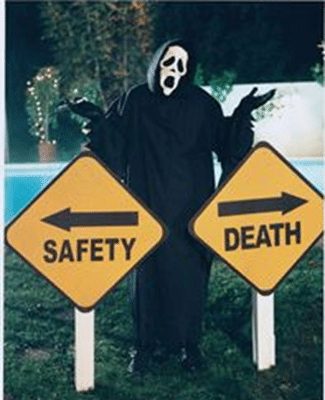Amping it Up in Safety
 In a recent blog I asked why are we afraid, and explored fear and how it may impact on our feelings, and decisions about risk. I also shared a story of how after the 911 terror attacks in 2001, American’s turned en mass to driving instead of flying. One result of this was an increase in the number of road fatalities during the first twelve months after they occurred, greater than the number of people killed in the terror attacks.
In a recent blog I asked why are we afraid, and explored fear and how it may impact on our feelings, and decisions about risk. I also shared a story of how after the 911 terror attacks in 2001, American’s turned en mass to driving instead of flying. One result of this was an increase in the number of road fatalities during the first twelve months after they occurred, greater than the number of people killed in the terror attacks.
One source of the fear that changed people’s commuting habits was the media with their overabundance of dramatic reports that filled our minds with images of death, destruction and horror in the months, and years after these events. It continues today. Could this have been part of the plan for the terrorists? Ironically, could it be that reporting by the media is now a greater risk, rather than the risk of actual event?
The media through their language, use of symbols, images and sound, greatly influence our unconscious and thus have a substantial impact on how we go about making decisions. Significantly, we may not even be aware of this influence unless we take the time to reflect and consider how we arrive at the decisions that we do. One of the ways to understand how the media are able to influence our unconscious mind is to consider what is either ‘amplified’ or ‘attenuated’ in media reports. This amplification or attenuation of messages will have an impact on how we make decisions, including about risk.
So how may we better understand amplification or attenuation and their impact on our decisions making?
In their paper published in 1988, Kasperson et. al. outline a valuable model known as the Social Amplification of Risk Framework (SARF) that they describe as;
“The main thesis is that hazards interact with psychological, social, institutional, and cultural processes in ways that may amplify or attenuate public responses to the risk or risk event. A structural description of the social amplification of risk is now possible. Amplification occurs at two stages: in the transfer of information about the risk, and in the response mechanisms of society. Signals about risk are processed by individual and social amplification stations, including the scientist who communicates the risk assessment, the news media, cultural groups, interpersonal networks, and others.”
What Kasperson et. al. accept is that risk is subjective, made up of a mish-mash of interactions and decisions involving people, feelings, culture, and hazards. They recognise that ‘signals’ are processed by people and by society and that these signals impact on our non-conscious decision-making. Paul Slovic in his book The Feeling of Risk explains in relation to ‘signals’, that;
“…such signals are subject to predictable transformations as they filter through various social and individual amplification stations. Such transformations can increase or decrease the volume of information about an event, heighten the salience of certain aspects of a message or reinterpret and elaborate the availability symbols and images, thereby leading to particular interpretations and responses by other participants in the social system. Slovic (2010, p. 318)
Effectively what Slovic, Kasperson and their fellow researchers suggest is that certain factors including images, symbols and language in communication may either amplify (heighten) or attenuate (dampen) the effect of messages, and thus impact on our decisions. Not only is this done through what is said (or written, or viewed, or listened to), but importantly also about what is not said (or not written, or not view, or not listened to).
The SARF model accepts the important role that our social arrangements have in our decision-making. This is why an understanding of social psychology is critical in our understanding of risk.
So this got me to thinking, do we in risk and safety, play a similar role in our organisations, to the role that the media plays in society in either ‘amplifying’ or ‘attenuating’ messages, and subsequently impact on risk? Are our messages and communication just as influential in how risk is dealt with in our organisations as those of the media in society?
Ironically, could it be that our reporting and communication in risk and safety is now a greater risk, rather than the risk of actual event?
What ‘signals’ may we create and send through our organisations? How may the language used in risk and safety ‘amplify’ or ‘attenuate’ feelings about risk? What effect do the images and symbols used in risk and safety have on decisions? What do we say and not say in risk and safety?
Should we concerned about amping it up in safety…..?
As usual, we’d love to hear your feedback, experiences, critique and ideas.
Author: Robert Sams
Phone: 0424 037 112
Email: robert@dolphyn.com.au
Web: www.dolphyn.com.au
Facebook: Follow Dolphyn on Facebook



Do you have any thoughts? Please share them below